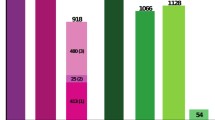Abstract
Objective: To determine whether knowledge of zidovudine treatment to reduce the risk of mother-to-child transmission of HIV increases the likelihood of HIV testing among women of childbearing age at increased risk for HIV infection. Method: Data from two samples were analyzed. The Young Women Survey was a population-based, door-to-door survey of 2,545 women aged 18 to 29 years who were living in lower-income neighborhoods. For the Perinatal Survey, women receiving prenatal care or who had delivered within the previous six months (N = 850) were recruited at randomly selected sites. Most (71.2%) of these participants were covered by public payment sources for their prenatal care. Data were collected within California counties with high rates of HIV among newborns, high rates of HIV among female clients of alternative test sites, and high rates of AIDS among female injection drug users. Most participants from both surveys were women of color. Results: Participants who knew about zidovudine therapy for HIV-positive pregnant women were more likely to have had an HIV test, regardless of race/ethnicity, age, education, or number of previous births. The majority of women (79.3%) from both samples stated that they were more likely to take a test for HIV knowing about zidovudine treatment. Conclusions: HIV educators should include information on zidovudine therapy in campaigns designed to promote HIV testing among women. Prenatal care providers should incorporate a brief discussion about the benefits of zidovudine treatment when providing HIV counseling to patients.
Similar content being viewed by others
REFERENCES
Connor EM, Sperling RS, Gelber R, Kiselev P, Scott G, O'Sullivan MJ, et al. Reduction of maternal-infant transmission of human immunodeficiency virus type 1 with zidovudine treatment. N Engl J Med 1994;331:1173–80.
Centers for Disease Control and Prevention. Public Health Service Task Force recommendations for the use of antiretroviral drugs in pregnant women infected with HIV-1 for maternal health and for reducing perinatal HIV-1 transmission in the United States. Morbid Mortal Weekly Report 1998;47:1–30.
Centers for Disease Control and Prevention. U.S. Public Health Service recommendations for human immunodeficiency virus counseling and voluntary testing for pregnant women. Morbid Mortal Weekly Report 1995;44(RR-7):1–15.
Centers for Disease Control and Prevention. Recommendations of the U.S. Public Health Service task force of the use of zidovudine to reduce transmission of human immunodeficiency virus. Morbid Mortal Weekly Report 1994;43:1–20.
Rogers MF. Epidemiology of HIV/AIDS in women and children in the USA. Acta Paediatr Suppl 1997;421:15–6.
Centers for Disease Control and Prevention. AIDS among children—United States, 1996. Morbid Mortal Weekly Report 1996;45:1005–10.
Nakchbandi IA, Longenecker JC, Ricksecker MA, Latta RA, Healton C, Smith DG. A decision analysis of mandatory compared with voluntary HIV testing in pregnant women. Ann Intern Med 1998;128:760–7.
Gorsky RD, Farnham PG, Straus WL, Caldwell B, Holtgrave DR, Simonds RJ, et al. Preventing perinatal transmission of HIV—Costs and effectiveness of a recommended intervention. Public Health Rep 1996;111:335–41.
Webber MP, Schoenbaum EE, Bonuck KA. Correlates of voluntary human immunodeficiency virus antibody testing reported by postpartum women. J Am Med Womens Assoc 1997;52:89–92.
Healton C, Taylor S, Burr C, Dumois A, Loewenstein N, Kaye J. The impact of patient education about the effect of zidovudine on HIV perinatal transmission: Knowledge gain, attitudes, and behavioral intent among women with and at risk of HIV. Am J Prev Med 1996;12:47–52.
Krueger LE, Wood RW, Diehr PH, Maxwell CL. Poverty and HIV seropositivity: the poor are more likely to be infected. AIDS 1990;4:811–4.
Diaz T, Chu SY, Buehler JW, Boyd D, Checho PJ, Conti L, et al. Socioeconomic differences among people with AIDS; results from a multistate surveillance project. Am J Prev Med 1994;10:217–22.
Capell FJ, Vugia DJ, Mordaunt VL, Marelich WD, Ascher MS, Trachtenberg AI, et al. Distribution of HIV Type 1 infection in childbearing women in California. Am J Public Health 1992;82:254–6.
SAS Institute Inc. SAS language: Reference, version 6, 1st ed. Cary, NC: SAS Institute Inc., 1990.
Data Points: Results from the 1997 California Women's Health Survey. Reason for most recent human immunodeficiency virus (HIV) test among women; California, 1997. Sacramento, CA: California Department of Health Services, Office of Women's Health, 1998.
Author information
Authors and Affiliations
Corresponding author
Rights and permissions
About this article
Cite this article
Ruiz, J.D., Molitor, F. Knowledge of Treatment to Reduce Perinatal Human Immunodeficiency Virus (HIV) Transmission and Likelihood of Testing for HIV: Results from Two Surveys of Women of Childbearing Age. Matern Child Health J 2, 117–122 (1998). https://doi.org/10.1023/A:1022944907256
Issue Date:
DOI: https://doi.org/10.1023/A:1022944907256




